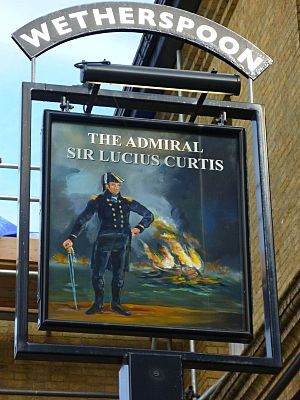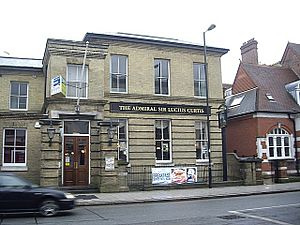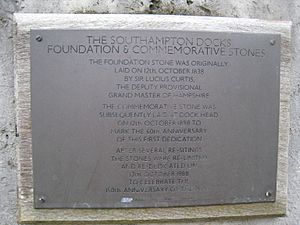Lucius Curtis facts for kids
Quick facts for kids
Sir Lucius Curtis, Bt
|
|
|---|---|

Portrait of Sir Lucius Curtis (with the frigate HMS Magicienne burning in the background) on a pub sign in Southampton
|
|
| Born | 3 June 1786 Portsea, Hampshire |
| Died | 14 January 1869 (aged 82) Portsdown Hill, Hampshire |
| Allegiance | |
| Service/ |
|
| Years of service | 1795–1869 |
| Rank | Admiral of the Fleet |
| Commands held | HMS Jalouse HMS Rose HMS Magicienne HMS Iphigenia HMS Madagascar Malta Dockyard |
| Battles/wars | Napoleonic Wars • Battle of Grand Port |
| Awards | Knight Commander of the Order of the Bath |
Admiral of the Fleet Sir Lucius Curtis, 2nd Baronet (born 3 June 1786 – died 14 January 1869) was an important officer in the Royal Navy during the 1800s. He was the son of Sir Roger Curtis, who was also a famous naval officer. Lucius Curtis fought in the Napoleonic Wars. He played a big part in the Mauritius campaign in 1810. During this time, he commanded the warship frigate HMS Magicienne. His ship was destroyed during the Battle of Grand Port.
Magicienne got stuck on a coral reef early in the battle. Even though Curtis and his crew tried their best, they had to leave the ship. Curtis then set it on fire so the enemy couldn't capture it. After being released from captivity in December 1810, he was cleared of any blame for losing his ship. He continued his naval career and later became an Admiral of the Fleet.
Contents
Lucius Curtis was born in 1786. He was the second son of Captain Roger Curtis. He joined the Royal Navy in June 1795 when he was just nine years old. His father was already a high-ranking admiral at the time.
Lucius first served on HMS Queen Charlotte. He was later promoted to midshipman, which is a junior officer rank. In 1801, he became a lieutenant, a more senior officer. His older brother, Roger, sadly died in naval service in 1802. This meant Lucius became the only son. His family connections helped him advance in his career.
In 1804, he was promoted to commander. This meant he was in charge of smaller warships. He commanded the sloop HMS Jalouse and then HMS Rose.
Commanding HMS Magicienne
On 22 January 1806, Lucius Curtis became a post-captain. This was a very important promotion. He took command of the frigate HMS Magicienne. His orders were to sail to the Indian Ocean. There, he would help block French ships from reaching the islands of Île Bonaparte and Isle de France (now Mauritius).
Curtis arrived in December 1809. He quickly made an impact. He spotted and captured the Windham, a large trading ship. The French had previously captured this ship.
The Battle of Grand Port
In 1810, Magicienne stayed near the islands. It helped with the Invasion of Île Bonaparte in July. Later, it supported Captain Samuel Pym near Grand Port. Pym wanted to stop French ships from entering the harbor.
On 20 August, a French fleet arrived. Pym tried to trick them into shallow waters to fight. But the French ships managed to get into the harbor. On 22 August, Pym decided to sail his ships directly into the harbor to attack.
However, the British ships did not have local guides. Pym's HMS Sirius, Henry Lambert's HMS Iphigenia, and Magicienne soon ran aground. They got stuck on the coral reefs that protected the bay. The last British ship, Nesbit Willoughby's HMS Nereide, was forced to surrender.
Of the stuck ships, only Iphigenia was able to sail again. But it was captured by the French five days later. Sirius and Magicienne were burned by their crews. This was to stop the French from capturing them. The sailors took shelter on a small island called Île de la Passe. Without food or fresh water, they had to surrender to the French. They were held prisoner until the British captured Isle de France four months later.
After the Battle
Curtis was completely cleared of any blame for losing his ship. This happened at a special naval hearing called a court martial. In 1812, he was given command of the recaptured HMS Iphigenia. In 1813, he commanded HMS Madagascar.
He continued to rise in the navy. He received an award called the Companion of the Order of the Bath in 1815. In 1816, he inherited his father's title, becoming a baronet. He also became a deputy lieutenant of Hampshire in 1817.
Later Career and Life
Curtis was promoted to rear-admiral in 1838. In 1843, he became the Admiral Superintendent of Malta Dockyard. This meant he was in charge of the naval base in Malta. He was promoted to vice admiral in 1849 and to full admiral in 1855. In 1862, he received an even higher award, the Knight Commander of the Order of the Bath. Finally, in 1864, he became an Admiral of the Fleet. This is the highest rank in the Royal Navy.
Sir Lucius Curtis was also a prominent freemason. He served as the head of the Freemasons in Hampshire from 1840 until his death. He passed away at his home in Hampshire on 14 January 1869. Since his oldest son had died before him, his baronetcy passed to his second son, Arthur.
Family Life
In June 1811, Lucius Curtis married Mary Greetham. They had three daughters and four sons together.



